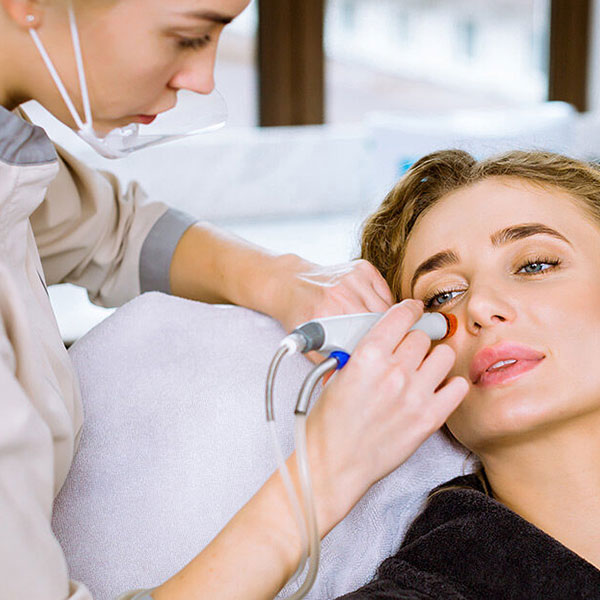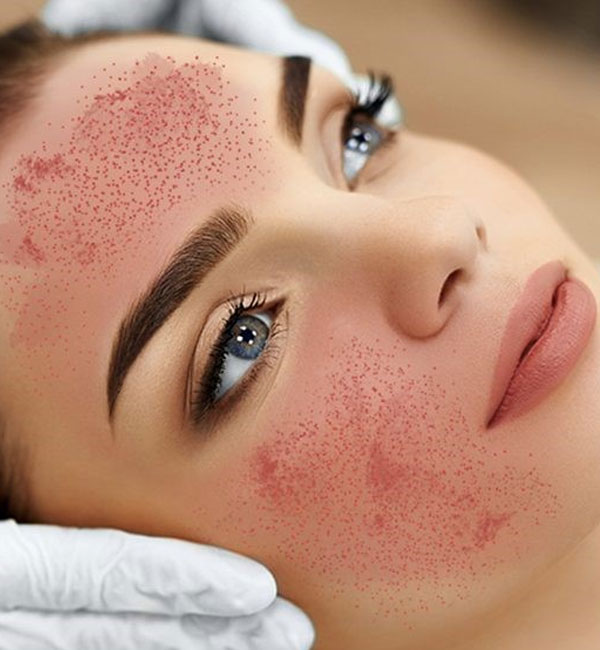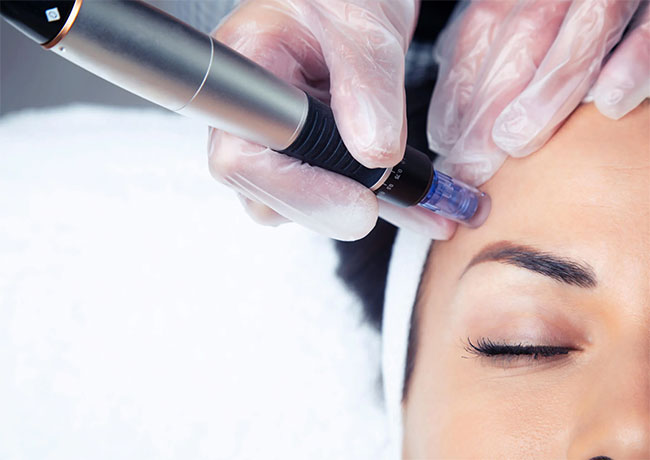Call Us - +91 9810575246

Acne
Acne is a skin condition that occurs when your hair follicles become plugged with oil and dead skin cells. It causes whiteheads, blackheads or pimples. Acne is most common among teenagers, though it affects people of all ages.
Effective acne treatments are available, but acne can be persistent. The pimples and bumps heal slowly, and when one begins to go away, others seem to crop up.
Depending on its severity, acne can cause emotional distress and scar the skin. The earlier you start treatment, the lower your risk of such problems.
What causes acne?
Acne occurs when the pores of your skin become blocked with oil, dead skin, or bacteria. Each pore of your skin opens to a follicle. The follicle is made up of a hair and a sebaceous (oil) gland. The oil gland releases sebum (oil), which travels up the hair, out of the pore, and onto your skin. Sebum helps keeps your skin lubricated and soft. One or more mishaps in this lubrication process can contribute to acne.
Acne might occur, for example, when:
- Your follicles produce too much oil
- Dead skin cells accumulate in your pores
- Bacteria build up in your pores
Any of these concerns can lead to pimples, which develop when bacteria grow in a clogged pore and the oil can’t escape.
NUTRITION
- Low glycemic index diet. Cutting back on foods with a high glycemic index, such as refined carbs and added sugars, could help reduce acne lesions.
- Milk products. Consuming certain milk products, like milk and ice cream, seems to worsen acne for some people. However, cheese, as well as nonmilk dairy products, don’t seem to worsen acne.
- Fat and fatty acids. Omega-3 and omega-6 fatty acids may help reduce acne breakouts.
These procedures work by removing damaged skin and reducing oil production. They include:
- Photo rejuvenation therapy: It uses a special light or laser to reduce oil production and bacteria. Other laser treatments can also help improve acne and scarring.
- Dermabrasion. This type of exfoliation removes the top layers of your skin with a rotating brush. The procedure works best for treating acne scarring, not acne itself. Microdermabrasion is a milder treatment that helps remove dead skin cells.
- Chemical peel. This treatment removes the top layers of your skin to reveal less damaged skin underneath. Chemical peels can improve mild acne scarring.
Even with treatment, flare-ups can still happen. Persistent acne may require additional or long-term treatment. It’s always best to work with a dermatologist to find the most effective treatment for regular or severe acne breakouts.
Preventing acne
It’s not always possible to completely prevent acne, but you can take certain steps at home to help lower your chances of getting pimples or acne breakouts.
Try these tips:
- Wash your face daily with an oil-free cleanser.
- Try an OTC acne cleanser to help remove excess oil.
- Use water-based makeup or products labeled “noncomedogenic” — this means they’re less likely to clog your pores.
- Avoid skincare and makeup products that contain oil.
- Always remove makeup and cleanse your skin thoroughly before bed.
- Shower or wash your face after exercising.
- Tie back your long hair to keep it out of your face.
- Avoid tight-fitting hats, headbands, and clothing that covers breakout-prone areas.
- Eat a balanced diet, and stay hydrated.
- Take steps to reduce stress.

Hyperpigmentation
Hyperpigmentation isn’t necessarily a condition but a term that describes skin that appears darker. It can:
- occur in small patches
- cover large areas
- affect the entire body
While increased pigmentation usually isn’t harmful, it can be a symptom of another medical condition. Learn about types of hyperpigmentation, causes, and how to treat it.
Types of hyperpigmentation
There are several types of hyperpigmentation, the common ones being melasma, sunspots, and post-inflammatory hyperpigmentation.
- Melasma. Melasma is believed to be caused by hormonal changes and may develop during pregnancy. Areas of hyperpigmentation can appear on any area of the body, but they appear most commonly on the stomach and face.
- Sunspots. Also called liver spots or solar lentigines, sunspots are common. They’re related to excess sun exposure over time. Generally, they appear as spots on areas exposed to the sun, like the hands and face.
- Post-inflammatory hyperpigmentation. This is a result of injury or inflammation to the skin. A common cause of this type is acne.
- Freckles. Freckles are small brown spots on your skin, often in areas that get sun exposure. In most cases, freckles are harmless. They form as a result of the overproduction of melanin, which is responsible for skin and hair color (pigmentation). Overall, freckles come from ultraviolet (UV) radiation stimulation.
What are the symptoms and risk factors?
Darkened areas on the skin are the main symptoms of hyperpigmentation. Patches can vary in size and develop anywhere on the body.
The biggest risk factors for general hyperpigmentation are sun exposure and inflammation, as both situations can increase melanin production. The greater your exposure to the sun, the greater your risk of increased skin pigmentation.
Depending on the type of disorder, other risk factors for hyperpigmented patches may include:
- oral contraceptive use or pregnancy, as seen with melasma
- darker skin type, which is more prone to pigmentation changes
- drugs that increase your sensitivity to the sunlight
- trauma to the skin, such as a wound or superficial burn injury
What causes hyperpigmentation?
A common cause of hyperpigmentation is an excess production of melanin. Melanin is a pigment that gives skin its color. It’s produced by skin cells called melanocytes. Several different conditions or factors can alter the production of melanin in your body.
TREATMENTS
Fair skin responds well to most hyperpigmentation procedures.
Medium skin tones may find the following options helpful:
- chemical peels
- microdermabrasion
Darker skin might benefit from:
- glycolic acid
- kojic acid
- OTC lightening creams
- microdermabrasion
- lower-strength chemical peels
- laser treatments, but only when used at lower intensities over a larger number of sessions

Medifacials
Radiofrequency Therapy
Radiofrequency treatments send energy waves into your skin that stimulate collagen production. The result can be firmer skin. Recently, radiofrequency treatments have been combined with microneedling treatments in order to send the energy waves even deeper into the skin. The needle penetrates the skin and releases radiofrequency into the channels, stimulating deeper layers of collagen.
FIRE AND ICE FACIAL
Like a facial, it rejuvenates the skin and like a chemical peel, it resurfaces and exfoliates the skin, and that too, without any downtime.
“The first step encapsulates a five-minute intensive resurfacing masque that consists of vital components such as sugar cane extract (a source of glycolic acid) (18 percent), citric acid, apple extract, retinol (vitamin A), niacinamide (vitamin B3), and potent antioxidants,”
This emits a warm feeling that lasts for 2-3 minutes and gives you a tingly and pleasant sensation. “It is the presence of actives like retinol, niacinamide and glycolic acid that helps with fine lines, wrinkles, acne, post-acne blemishes and uneven skin tone.”
The second step encapsulates an intensively hydrating masque designed for a soothing, cool experience that leaves the skin revitalised and glowing. This step gives off a calming and comforting sensation to the skin, thereby leaving it nourished.
It is clinically articulated with hyaluronic acid, Japanese green tea, grape seed, rosemary, licorice, and aloe vera extracts. The cooling sensation provides the ‘ice’ to the facial. Hyaluronic acid can hydrate the skin, treating dryness and making the skin plump, smooth, and shiny.

Hydrafacial
Every Hydra facial consists of these three simple steps–but offers endless ways to personalize based on your skin goals.
CLEANSE: Deeply cleanse and soften skin to help loosen dead skin cells and prep for extractions.
EXTRACT: Remove congestion from pores with painless suction.
HYDRATE: Saturate the skin’s surface with intense moisturisers and nourishing peptides.
Benefits:-
- Fine lines and wrinkles
- Elasticity and firmness
- Hydration
- Congestion and acne
- Dark spots
- Pigmentation
- Pore size

Vampire Facial
Step 1 – The blood is drawn from your veins.
Step 2 – The drawn blood is placed in a centrifuge and the platelets are separated from the red blood cells.
Step 3 – The platelets will be directly injected into your skin to stimulate collagen.
Step 4 – or there is another way with treatment combined with others, like micro-needling (occasionally with radiofrequency), microdermabrasion, or a resurfacing laser.
Step 5 – The remaining blood or RBCs can be used as a mask on the face.
Benefits
Those with premature wrinkles, high levels of sun damage, or anyone who desires a fresher, more even-toned complexion are ideal candidates for the vampire facial. However, if you have a history of blood diseases, including clotting or bleeding disorders, you should avoid treatments.

Oxygeneo Facial
How does it work?
The OXYGENEO facial offers three primary steps to beautify your skin: exfoliation, oxygenation, and infusion.
Exfoliate – The OXYGENEO treatment starts with exfoliation to gently remove the dead skin cells from the upper layer, make the skin smooth, clean clogged pores, and renew your skin. It generates CO2 bubbles in high amounts to the trigger Bohr Effect, which is a physiological response by the topmost skin layer.
Oxygenate – The Bohr Effect is an oxygenation process for your skin. When it is triggered, O2-rich blood is sent to your skin, and it replaces the CO2. Through this process, the OXYGENEO treatment oxygenates your skin from within, improving cellular activity.
Infuse – Along with oxygenation, OXYGENEO facial also infuses vitamins, nutrients, and other active ingredients. These ingredients not only make your skin healthier and well-nourished but they also make the skin tone smoother.
Benefits
OXYGENEO treatment for the body offers multiple benefits that contribute to the overall beautification of the skin. These benefits include:
- Smooth skin texture
- Reduction of wrinkles
- Skin tightening
- Complexion lightening
- Healthy glow
- Hydration of skin
- Reduction of irritations
- Pigmentation reduction
- Calms down sensitive and irritated skin

Microneedling
Microneedling is a cosmetic procedure that uses small, sterilized needles to prick the skin. The purpose of this treatment is to generate new collagen and skin tissue to smooth, firm, and tone skin.
BENEFITS
- Microneedling is mostly used on the face and may reduce the appearance of acne, scars, dark spots, wrinkles, and large pores.
- Microneedling is minimally invasive, requiring little to no downtime.
- It’s considered safe for most people who are in overall good health.

Microdermabrasion
Microdermabrasion is a minimally invasive procedure used to renew overall skin tone and texture. It can improve the appearance of sun damage, wrinkles, fine lines, age spots, acne scarring, and other skin-related concerns and conditions.
Benefits
- Microdermabrasion is a simple, quick, and painless cosmetic treatment with no downtime and minimal risk.
- Microdermabrasion helps to gently exfoliate surface layers of skin using abrasion and suction.
- Microdermabrasion uses fine crystals or minutes of diamond-studded tips to abrade the skin and vacuum suction to remove dead skin cells.
- Microdermabrasion has low risk and rapid recovery.
- The skin may become noticeably smoother even after one treatment and better absorb moisturizers.
- Most often, microdermabrasion may be repeated every three to four weeks for optimal results

Cosmeceutical Peels
Chemical peels utilise chemical solutions that are applied to the skin to cause controlled exfoliation and remove damaged, outer layers. The new, regenerated skin has improved appearance and texture. Here at Rejuvenate Aesthetic Clinic we offer various types of Cosmeceutical Peel.
BENEFITS
- Minimally invasive
- Quick, walk-in, walk-out procedure
- Minimal downtime
- Suitable for most skin types
- Improves the appearance of acne scars and another scarring
- Improves active acne by reducing bacteria growth and removing congestion
- Improves the appearance of fine lines and wrinkles
- Revitalises texture of photo-damaged skin
- Evens skin tone and restores radiance
TYPES OF COSMECEUTICAL PEELS
Vitamin C peel:- It is a nano peel formulated for skin that requires glow and radiance on the face and body. It is an excellent peel for nourishing Vitamin C into the deep layers of skin, resulting in overall rejuvenation of the face and body.
Salicylic Peel:- It is specially formulated to have mild to severe acne. It is also effective for skin rejuvenation. It leaves your skin clearer, brighter, and more youthful. Suitable for all skin types. The Peel is effective for anti-acne treatment, it exfoliates the areas with acne while peeling takes place to destroy the bacteria accumulated
Glycolic Peel:- It is used to improve the skin’s appearance and texture. It reduces wrinkles, acne scarring, and hyperpigmentation and improves many other skin conditions including actinic keratosis, hyperkeratosis, and seborrheic keratosis.
Pyruvic Green Peel Combination:- The Nano Peel is formulated to treat patients with anti-aging and melasma. Its enzyme reactivator rejuvenates and strengthens extremely sensitive, sun-damaged skin. It has a medium-depth effect. It normalizes the skin for overall softer, supple skin.
Retinol Yellow Peel:- It is one of the most powerful cell-communicating, anti-aging ingredients to help re-texturize and dramatically reduce wrinkles. It can combat the early signs of aging and correct existing photodamage. It can treat photo-aging, stretch marks, hyperpigmentation, acne, and melasma.
